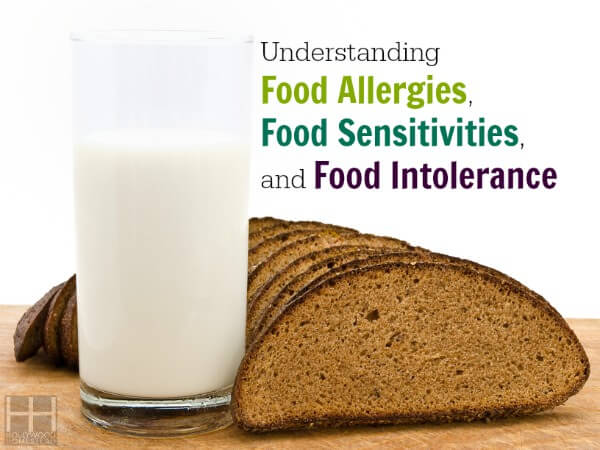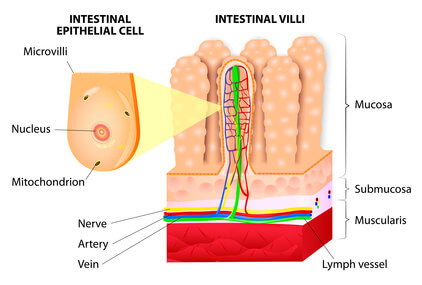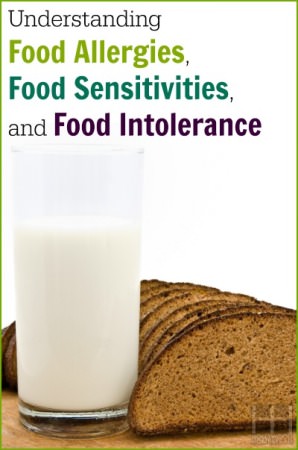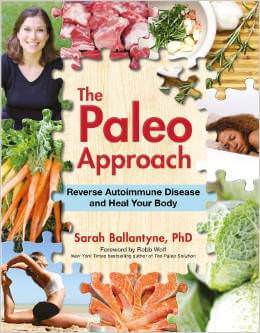
Does it seem like everything you eat causes some sort of bad symptom, like bloating, gas, or skin rashes? In order to beat these symptoms for good, it is important to understand the difference between food allergies, food sensitivities, and food intolerance.
Food Allergies
A food allergy is an allergic reaction in which your body thinks a substance which is normally harmless is something harmful. The immune system releases its soldiers (in this case, histamines) to fight off the substance. The result is a lot of inflammation and some nasty symptoms like diarrhea, rashes, and stomach ache.
Food Sensitivities
A food sensitivity is any food which irritates the digestive tract. Milk is probably the most well-known food sensitivity but people are finally figuring out that wheat is a major irritant too.
Like with a food allergy, the irritation caused by food sensitivities leads to inflammation in the digestive tract. So, a lot of the symptoms of food sensitivity are the same as allergies.
It is easy to understand why we get the two confused. One of the major differences between a food allergy and sensitivity though is that the symptoms of a food allergy occur immediately (hives for example). With food sensitivity, symptoms might not show for a few hours or even a day (diarrhea, brain fog…). This can make it hard to pinpoint which food is causing the reaction. (Source)
Food Intolerance
The terms “food sensitivity” and “food intolerance” are often used interchangeably. However, they are different in that food intolerance occurs when the body lacks an enzyme to digest a substance (such as the lactose enzyme in lactose-intolerant people).
Food sensitivities can occur even when the person has enzymes which could digest the food but may be unable to do so because of other problems, such as excess consumption or a damaged gut. Both conditions have similar symptoms and can lead to gut inflammation and leaky gut syndrome.
Why Food Sensitivities and Food Intolerance Are Such a Major Concern
Food allergies are no fun, but you can generally pinpoint them fairly easily and learn to avoid them. With food sensitivities and intolerance, the symptoms can appear hours after eating the guilty food.
In both cases, the food causes inflammation and irritation to your gut. Over time, this can lead to the serious disease Leaky Gut Syndrome.
Occasionally consuming a food which irritates the digestive tract wouldn’t be such a terrible thing because the gut would have time to heal itself. I’m not saying you should eat foods that cause irritation, but it won’t be the end of the world if you have some goat cheese as a treat every once in a while.
But many of us on today’s SAD diet eat pretty much nothing but digestive irritants.
Just consider all the people who eat a bagel for breakfast, a sandwich for lunch, crackers for a snack, and then top it off with a baguette with dinner.
That’s wheat at every meal!
Now add all the other digestive irritants which are found in processed foods to the mix, such as the red dye number 40 in that cupcake or whatever additives are lurking in the processed deli meat, and you end up with a gut that is constantly inflamed.
Constant inflammation of the gut is going to affect the villi lining your gut. This set off the chain reaction which results in leaky gut syndrome.

If you are experiencing any gastrointestinal symptoms, you should take steps to diagnose yourself for food sensitivities or intolerance. But, remember, the gut is linked to all parts of the body.
Leaky gut syndrome can cause a wide range of symptoms including headache, fatigue, brain fog, rashes, and nutritional deficiencies (and their subsequent symptoms).
Leaky gut syndrome is the precursor to all autoimmune diseases, so these symptoms must be taken seriously! Ideally, you should catch gut problems before they turn into full-blown leaky gut syndrome. If you think you have leaky gut syndrome, read about how to diagnose leaky gut and how to repair leaky gut.
Diagnostic Tests for Food Allergies, Sensitivities, and Intolerances
There are a lot of different tests available for diagnosing specific food allergies, sensitivities, or intolerance. However, these are the most common ones you will find.
IgE Antibody Test (food allergy test)
- IgE antibodies bind themselves to the allergic food and a special “mast” cell. The mast cell contains histamine. When body is exposed to the allergic food again, the antibody will instantly create symptoms.
- IgE antibodies are primarily located in the lungs, skin, and mucus membranes and produce symptoms like hives, swelling, wheezing, rashes, diarrhea, and trouble breathing.
- Only IgE reactions are considered true allergies.
IgG Antibody Test (food sensitivity test)
- IgG antibodies bind themselves directly to the food as it enters the body and then circulate in the bloodstream. They do not bind to mast cells like IgE antibodies.
- IgG antibodies are found in all body fluids and can cause symptoms like migraines, irritable bowel syndrome, bloating, indigestion, and eczema.
- Symptoms can take hours or days to appear
- This is the most commonly used test for food sensitivities because the IgG antibodies are present in the body for long periods of time.
IgA Antibody Test (food sensitivity test)
- IgA antibodies are abundant in the mucus membranes of the gut and respiratory passages.
- IgA antibodies may form if the lining of the gut becomes damaged or inflamed.
- They are the only antibody that gets secreted into the digestive fluids and are thus specific to digestive problems.
- Many people (about 1 in 500) have a deficiency in IgA. This is considered an immune disorder and its cause is unknown, though evidence shows there is a genetic component and that stress could cause IgA deficiency. People with IgA deficiency can experience allergy-like symptoms. Low IgA is also linked to celiac disease.
- It is possible for IgG tests to be negative and IgA tests to be positive, or vica versa. The IgA test is recommended for people with suspected leaky gut syndrome
Food Intolerance Tests
- A food intolerance is when your body lacks a specific enzyme required for digesting a food, such as the lactose enzyme in lactose intolerant people. A food sensitivity is when the body negatively reacts to a food.
- Depending on the suspected intolerance, different tests may be used including hydrogen breath tests, glucose-level blood tests, and stool tests.
UPDATE:
Good news! There is now a food sensitivity test that you can order directly without a doctor’s order! While I’m a HUGE fan of having a doctor’s guidance, I understand the need to know whether you have a food sensitivity before investing in a practitioner.
- USA: Order the test here
- Canada: Order the test here
- Europe: Order the test here
Self-Diagnosis for Food Sensitivities
Unfortunately, food sensitivity tests can be a bit pricy. Further, for the test to be accurate, you must still have the antibody in your system.
In order words, if you haven’t eaten gluten in a while and take the gluten sensitivity test, it will come back negative even if you do have a sensitivity.
If you have the patience, you can self-diagnose food sensitivities using an elimination diet (also known as Paleo Autoimmune Protocol or AIP).
This basically involves putting yourself on a very strict diet for at least 30 days. During this time, you must be vigilant about avoiding ALL possible food sensitivities. Many foods could be to blame, but the big ones to avoid are:
- Gluten
- Grains
- Nuts
- Legumes
- Eggs
- Alcohol
- Caffeine
- Nightshades
- Processed sugars
- Processed foods
If your symptoms improve after 30 days, then a food sensitivity (or allergy or intolerance) is to blame. Next, you have to figure out which food is to blame. You do this by gradually reintroducing foods back into your diet.
You MUST reintroduce foods one at a time.
Introduce one food back in per week. If the symptoms don’t return, then that food isn’t to blame. The next week, you can move onto a new food. If symptoms reoccur, then you’ve found the culprit. There might be more than one culprit, so continue to reintroduce foods slowly!
This diagnostic approach takes time, and you have to be really dedicated to sticking to the diet. But, if you are patient, this is the best method to self-diagnose for food sensitivities, allergies, and intolerance.
To learn more about the details of the elimination diet, what to eliminate, and when/how to reintroduce foods back into your diet, I highly recommend the book The Paleo Approach by Sarah Ballantyne. She even gives you tips on how to make the AIP diet work for your lifestyle and budget.
*Note that an elimination diet won’t tell you whether you’ve got a food sensitivity, intolerance, or allergy. This shouldn’t matter too much since the course of action will be the same: avoid that food!
Food sensitivities and intolerance can take a serious toll on your gut, causing holes to form in it and causing leaky gut syndrome. It is imperative that you avoid foods which harm your gut and also start repairing your gut. Read more about what is leaky gut syndrome, how to diagnose leaky gut syndrome, and how to repair leaky gut.

Latest posts by Sylvie McCracken (see all)
- Treating H. Pylori (Part 3): What H. Pylori Does to the Body - August 8, 2022
- Treating H. Pylori (Part 2): How H. Pylori is Contracted - August 3, 2022
- Understanding Beef Labels: Organic, Pastured, Grass-Fed & Grain-Finished - July 25, 2022

As a mom of kids with all degrees of allergies I find this interesting. But it should be noted that “sensitivities” are actually allergies as well. They are called latent allergies and still have a similar impact on the body. They do not cause life-threatening reactions like some allergies, but they are still allergies and should be treated the same.
Thank you! Glad it was helpful!
BTW, sharing on FB 🙂
I really appreciate reading about the IgE test and think asthma must fit into this category. If so, it’s really cool that gut work can even heal true allergies. Cheers and thank you. 🙂
Thank you! Glad it was helpful!
Thanks for this comprehensive overview. So many people today suffer from food sensitivities/allergies, not to mention leaky gut. . . having some guidlines and strategies is really helpful!
Thanks Ricki! Glad you found it helpful.